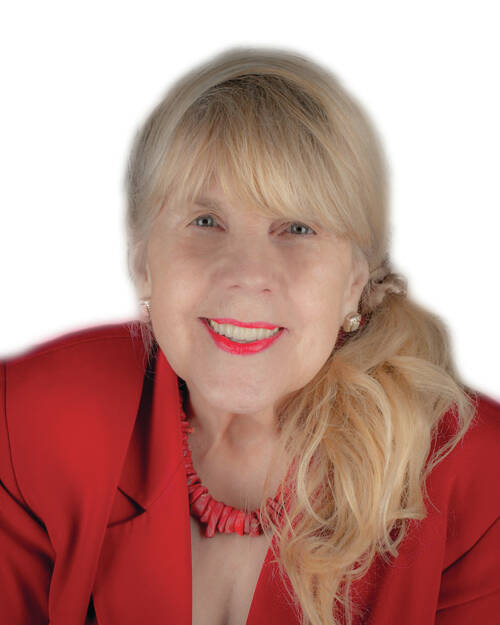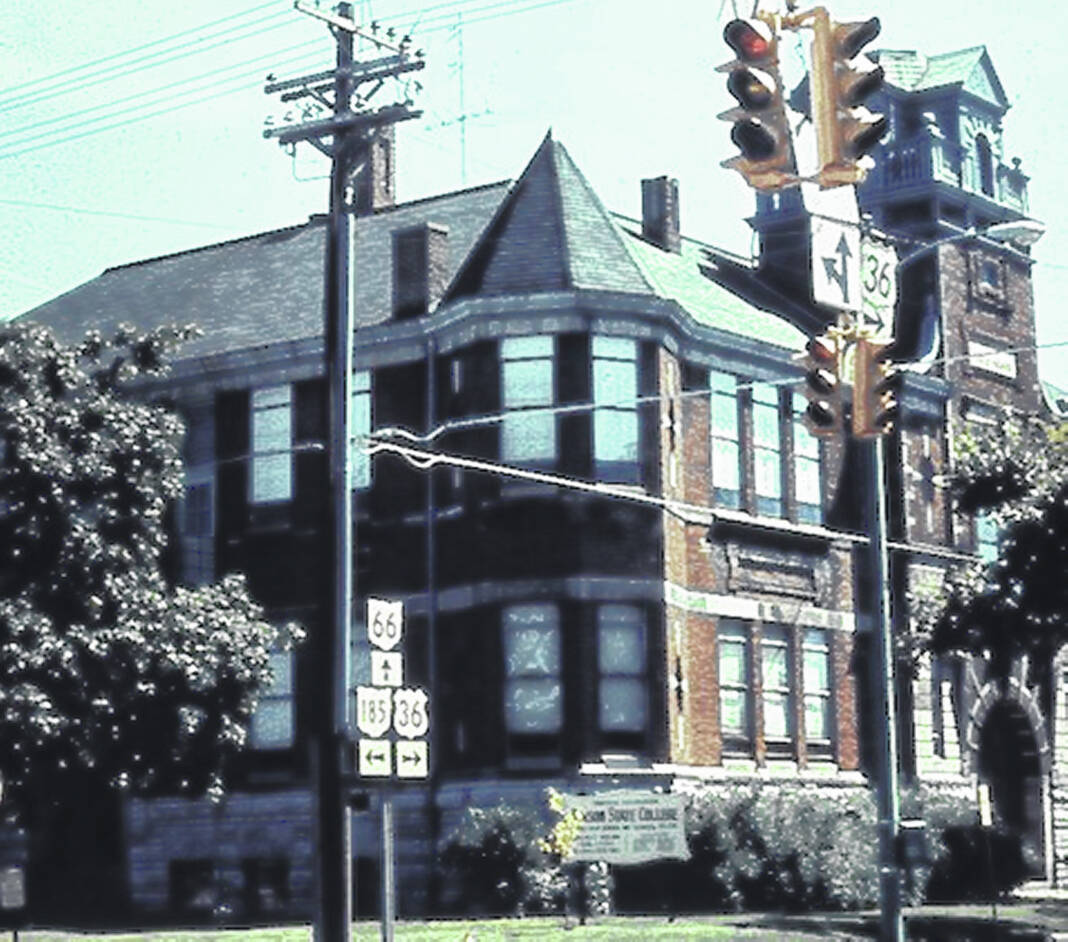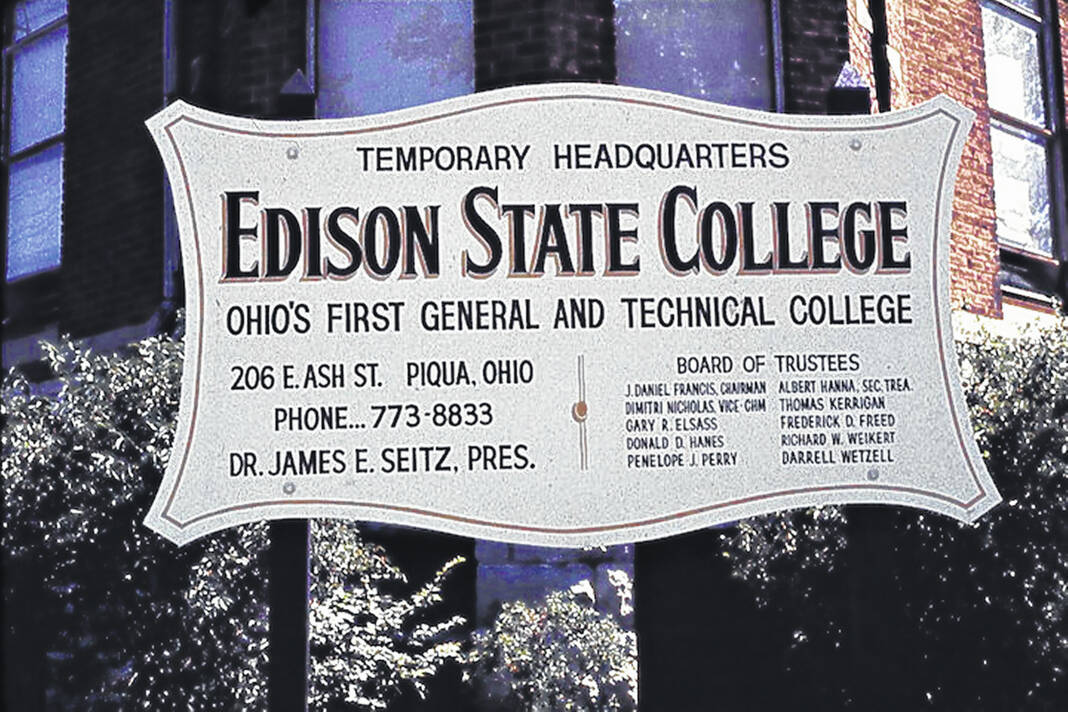

Edison State began educating local students in the former Spring Creek Elementary School.
Courtesy photo

Known today as Edison State Community College, but when it first opened it was known as Edison State General and Technical College.
Courtesy photo
By Vivian Blevins
Contributing Columnist
At one time in this country, higher education was delivered in ways that sent out clear messages of exclusion. And then community colleges began to arrived on the scene in the late 1960s with a commitment that, in time, community colleges would be accessible throughout the country. And the planning began.
It was 1973 with Watergate, the opening of the Sears Tower, the promise of an end to the Vietnam War, and the invention of the first handheld mobile phone. This also was the year when Edison State Community College was chartered by the state to serve residents of Darke, Miami and Shelby counties. It was the first state general and technical college in Ohio. There were 309 students enrolled in 30 classes in the 1973-1974 year, and the college was initially housed at what was Spring Creek Elementary School. Today, the Piqua Camus of Edison State occupies a 130-acre campus with additional campuses in Greenville, Troy, and Eaton.
David Johnson, one of the first faculty to be employed reminisces, “When I was hired to teach English composition, literature, and technical writing, the college was known as Edison State General and Technical College. Wright State University faculty provided the instruction the first year, and then it was turned over to the five faculty who were hired in addition to me.”
Johnson continues, “It was my sense that my job was to teach my students basic writing skills, research skills (We had one room for the library with Cathy Oda as librarian), and to encourage the development of critical thinking skills.” Dr. James Funkhouser (1975-2010) indicates that innovation in order to improve instruction in colleges is essential, and he writes, “I don’t know anyone who put more emphasis on and invested more time in finding readings that would be interesting to students while challenging them to develop the critical skills than David. He considered critical thinking essential, and he was determined that teaching composition not be reduced to a “recipe.”
Another of those very early faculty was Keith Roeth (1974-2005). “At Spring Creek School, our faculty offices were in the basement, converted from a boys locker room. We shared many experiences in those offices as we discussed our roles.. Here in West Central Ohio, many of the students in those first years were persons who had not previously had an opportunity to attend college. They had jobs; they had families; they were paying their own way. Students knew each other and would walk out of English straight into my biology class. They wanted to know more about the outside world. David grew up outside of Chicago and had worked with his father, an immigrant from Sweden, who had a construction business. He understood our students and had a strong and sincere desire to help them, to give them a better step up. We all did.”
In regard to use of technology, Johnson says, “I guess I was the forerunner in terms of the use of technology in English courses. My son was working at Panasonic, and I introduced him to a word processing system called Textra. The system was first on a floppy disc and then a hard disc and very easy to use. I will concede, however, that it took us a while to get familiar with what we were doing.” Before long, Johnson, sensing that technology was the coming thing, had all English faculty using a program called ConnectWeb.
In addition to Johnson’s being a forerunner in technology, retired Edison State professor, Cathryn Essinger (1986-2012) relays, “Johnson was the voice of the faculty as president of the academic senate and then as president of the faculty union. In those roles and in his visits to faculty offices, he gave the faculty a sense of cohesion. Once the college moved to the current location, there was a myth on campus that anything truly academic happened on the second floor where mostly liberal arts faculty were housed, and there is still only one second floor at the college.” Johnson was also known as a curmudgeon, and Essinger reports that he hated Bloom’s taxonomy which he called “an invention of the devil to keep students from thinking.” He also hated the “endless array of forms.”
Dr. Jim Hart, (1981-2005) retired psychology professor, says, “I was always impressed with David’s vocabulary. He could tell you the origins of virtually any word. And he had a talent for poking fun when he thought the college was doing something he believed was stupid, senseless. He wrote scripts where he played a prof who was obsessed with these issues and called him Professor Snark.”
In conclusion, I continue to enjoy hearing these stories at the monthly meetings of the retirees known as the DimBulbs (Do you get the joke? Edison State? Thomas A., inventor of the light bulb?) at the North Star Coffee Station where I update them on recent events at the college. Their camaraderie, their wonderful connections that closely border on love, fascinate me. I want to reveal a little of what Jesse Parete (1978-2009) recently wrote. He began the email with a confession about how he and Johnson regularly went into Richard Bollenbacher’s (1976-2010) office when Dick wasn’t there to drink Dick’s coffee. Then he wrote a joke about a dean of a community college, a joke I didn’t understand. He concluded his memo by reveling in all the fishing trips that he and other faculty, including Johnson, enjoyed at local ponds and that David Johnson received a gift from the college of fishing equipment when he retired in 2009.
How has your local community college impacted your life and the life of your family? If you are willing to do so, send me an email ([email protected]). Perhaps I will write another column about this subject.

